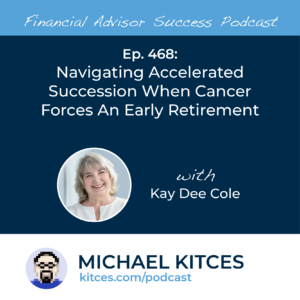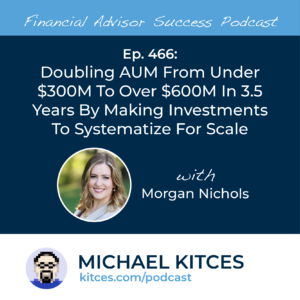 Welcome everyone! Welcome to the 468th episode of the Financial Advisor Success Podcast!
Welcome everyone! Welcome to the 468th episode of the Financial Advisor Success Podcast!
My guest on today's podcast is Kay Dee Cole. Kay Dee is the founder of Clarity Wealth Development, an RIA based in Corvallis, Oregon, that oversees approximately $200 million in assets under management for 220 client households.
What's unique about Kay Dee, though, is how she has navigated an accelerated succession plan within a growing firm after experiencing a recurrence of cancer and deciding to transition away from the business.
In this episode, we talk in-depth about how Kay Dee initially sold a minority stake in her firm (using a seller-financed loan) to her Chief Operating Officer (who had taken many aspects of running the business off of Kay Dee's plate) with plans to increase the stake over time, how Kay Dee's cancer recurrence has led her to speed up the equity transition, with her planning to give other firm employees the chance to buy in as well, and how Kay Dee is thinking through whether to hold on to the seller-financed loans (which could create stress by continuing to tie her to the business and its success even though she's retired) and how this decision will impact her own finances.
We also talk about how Kay Dee initiated a four-meeting process to transfer her clients to other advisors in her firm (with a senior advisor leading the first meeting and giving the other advisor an increasing role until they are ready to lead the relationship), how Kay Dee and other “first chair” advisors have regular one-on-ones with more junior advisors throughout this transition process to review previous client meetings and to game plan together for the next one (allowing both sides to gauge the junior advisor's readiness to take on more responsibility), and how Kay Dee communicated this advisor transition plan to clients and made them aware of her condition and plans to retire (only losing a few clients [who were likely planning to leave anyway] in the process).
And be certain to listen to the end, where Kay Dee shares how her firm has created four client segments based on AUM to ensure the level of service being provided (for instance, number of meetings per year or the seniority of advisor they're working with) is in line with the fees they pay (helping it double its AUM to $200 million in 5 years), how Kay Dee's adoption of the Entrepreneurial Operating System and its principles has helped her build more durable structures for her firm (amidst the ongoing transition) and open up lines of communication with her partner and employees, and how Kay Dee has found success in part by prioritizing in-person interactions with fellow advisors and industry professionals (whether at conferences or informally for coffee chats), allowing her to gain new insights and build relationships in a way that's harder to replicate in an online environment.
So, whether you're interested in learning about creating an adaptable succession plan to prepare for unforeseen circumstances, transitioning clients to new advisors while maintaining high retention, or segmenting clients into different service models to ensure profitability, then we hope you enjoy this episode of the Financial Advisor Success podcast, with Kay Dee Cole.




